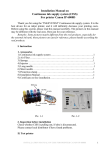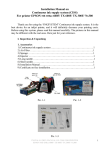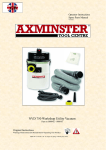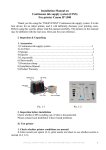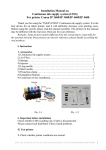Download Bosch HBA64B251B
Transcript
*9000042309* 9000042309 920613 Ú Installation instructions PLQ PLQ & % % ( PLQ PLQ PLQ ' PLQ PLQ en Ú Ins tal la tion i ns tru cti on s Preparing the unit: figure 1 ■ ■ ■ ■ ■ ■ For the housing units, the sheets and plastic coatings must have been completed using an adhesive which is heatresistant at 90 ºC for the unit interior (where the oven will be positioned) and 70 ºC for the adjacent units (located to the side of the oven). If the sheets and plastic coatings or the adhesive do not have sufficient heat resistance, the units may become deformed or burned. In this case, the oven manufacturer cannot be held responsible for the damage caused to the unit. The units must be cut before installing the oven. Remove any wood chippings as they could affect the working of the oven components. The oven connection box must be positioned in shaded surface area B or in an area where it does not interfere with the oven assembly. Any free-standing units must be fastened to the wall at the normal angle C. The oven housing unit requires a ventilation opening at the base. If the oven is fitted below a hob, follow the hob's assembly instructions. Fitting the oven in a high unit: figure 2 The oven can also be assembled in a high unit. For ventilation, there should be a 20 mm gap approximately between the lower shelf and supporting wall and another 20 mm gap between the upper shelf and supporting wall. It is recommended that a gap of 590 mm is left between the lower and upper shelf for proper ventilation. This gap could be increased to 595 mm if you want greater ventilation than recommended. Ovens with a pull-out carriage door should be assembled so that the baking trays can be easily removed. Assembling the oven in a corner: figure 3 When assembling the appliance in a corner, the dimensions in figure D must be taken into account. It is recommended that for the measurements in figure E, the width of the front part of the unit and the handle are taken into account. Connecting the oven to the mains ■ ■ ■ ■ ■ ■ ■ ■ ■ Before using the appliance for the first time, you must check that your house has an earth connection and fulfils all the applicable safety standards. Your appliance must be installed by an authorised technician. The requirements of the regional power supply company and national ones apply. The use of this appliance without an earth connection or when not installed correctly can cause serious damage (personal injury and death by electrocution), albeit this is highly unlikely. The manufacturer accepts no responsibility for any malfunction or damage which is caused by unsuitable electrical installations. The oven must be disconnected from the mains during all assembly operations. The oven has class I protection and should only be operated with an earth connection. The cable for connecting the oven to the mains must be H05 V V-F 3G 1.5 mm² or higher. The yellow and green colour cable, which is used for the earth connection, should be connected first and should be longer than the others. To fulfil the normal safety requirements, the installation technician should ensure that a cut-off switch is installed on all poles with a contact opening of less than 3 mm. This is not necessary if the appliance is connected via a plug, if this is accessible to the user, and provided it is earthed. The assembly must ensure protection against manual contact. The oven must be connected taking into account the voltage indicated on the oven's specifications plate. To connect the appliance it should be positioned in front of the unit. The connection cable should be long enough to ensure connection. Warning! Make sure the connection cable does not become trapped during installation and that it does not come into contact with the hot parts of the oven. Any handling of the appliance, including changing or installing the power cable, must be performed by the Technical Assistance Service. Positioning the oven in the unit: figure 4 ■ ■ ■ ■ ■ For ovens with a pull-out carriage door, the door must be removed. Push the oven completely into the space in the unit provided for this purpose. Make sure the cable has not been stripped by the oven edges, that it is not in contact with hot parts and that it does not run along the bottom of the oven. Centre the oven in the unit and fasten with the screws (4x25) supplied. If the unit has been built according to the measurements provided, there will be a gap at the top of the oven. Do not cover this gap with wooden slats so as to allow sufficient ventilation. There should be at least a 5 mm gap between the appliance and the adjacent units (located beside the oven). Dismantling Disconnect the oven from the mains. Loosen the screws that fasten the oven to the unit. Lift the oven slightly and remove it completely from the unit.


